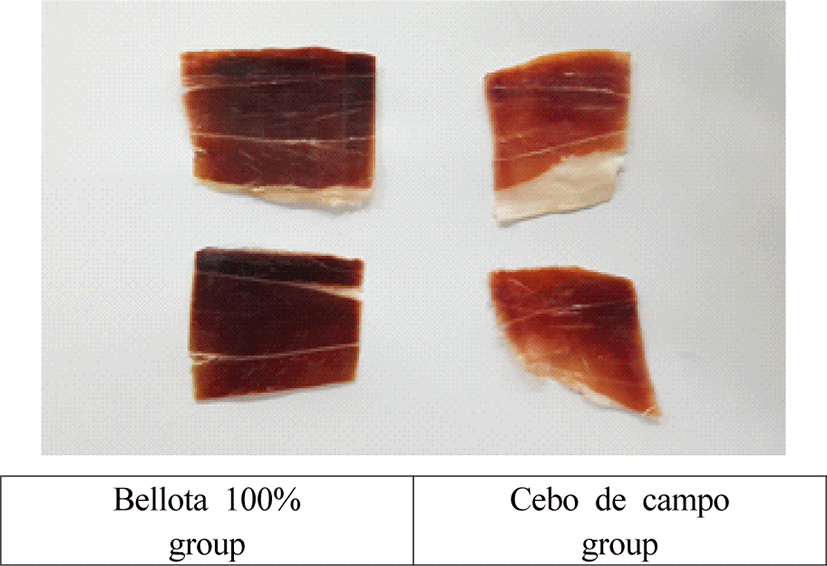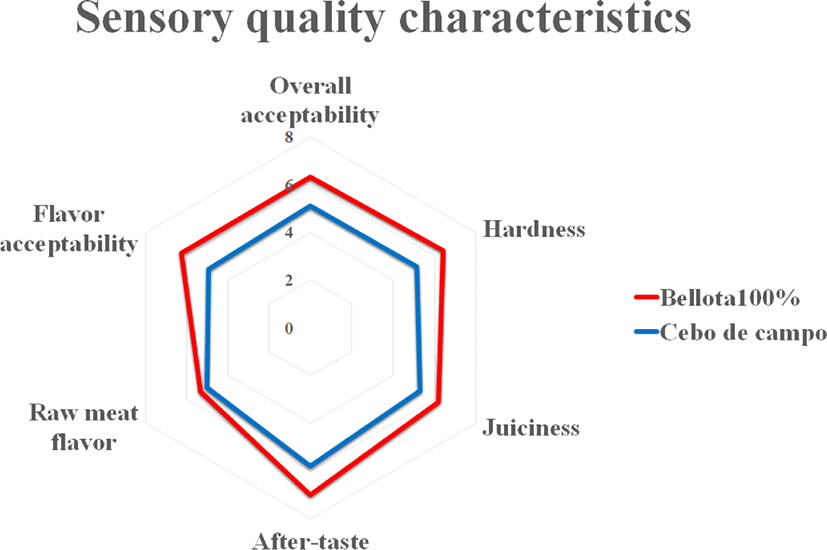Ⅰ. 서 론
국내 1인당 육류 소비량은 소득향상 및 경제적 발전과 함께 지속적으로 증가하고 있으며, 식육 중 가장 많은 소비를 나타내는 것은 돈육이다. 하지만 국내 돈육 생산량은 소비량에 못 미치고 있으며, 부족한 부분은 수입에 의존하고 있어 최근 몇 년 돈육 수입량이 증가하는 추세이다. 주요 수입국으로는 미국, 독일 및 스페인이 있으며, 특히 스페인산 수입량은 전년 대비 약 60%가 증가하였는데 (2018년 기준), 이는 스페인에서 사육되는 이베리코 품종에 대한 국내 소비자 관심에 기인한다.
이베리코 품종은 이베리아 반도의 자연 재래종으로, 타 품종과 유전 및 사육방식특성에서 차이점을 나타낸다 (Ali et al., 2021; Serra et al., 1998). 유전적인 면에서 보면, 이베리코는 렌드레이스와 요크셔 등 백색돈에 비해 근내지방 함량이 높게 나타나는데, 예를 들어 이베리코 등심근의 지방함량은 약 4-10% 정도로 일반적인 삼원교잡종에 비해 2-5배 높은 수치이다 (Lopez-Bote, 1998; Pugliese and Sirtori, 2012). 이베리코의 전통 사육방식은 방목이며, 방목은 Dehesa라고 불리는 참나무가 많은 숲에서 도토리가 떨어지는 시기 (11월~3월; Montanera)에 실시하여 도토리와 풀을 섭취할 수 있는 환경을 제공해준다 (Cava et al., 2003; Díaz-Caro et al., 2019; Lopez-Bote, 1998).
국내 이베리코 돈육의 수입은 대부분 구이용 (목살, 전지 등)으로 판매되고 있다 (Ali et al., 2021). 하지만, 이베리코의 주 생산 목적은 건염햄 (하몽)을 만들기 위함이고, 하몽은 뒷다리로 건조 염지 숙성을 하여 제조하며, 이베리코 하몽은 세계적으로 잘 알려져 있다 (Petrova et al., 2015). 이베리코 하몽은 품종 및 사육환경에 따라 5등급 (베요타 100%, 베요타, 세보데깜보, 세보, 세라노)으로 분류하고 있다 (Mesias et al., 2009). 예를 들면 스페인어로 도토리라는 뜻을 지닌 베요타 100% (Bellota 100%) 등급은 이베리코 순종을 최소 17개월 이상 사육하며, 그중 Montanera 시기에 최소 3개월 이상 방목시켜 도토리를 섭취한 돼지에게서만 받을 수 있는 등급이다 (Rodríguez-Estévez et al., 2009, 2011). 또한 베요타는 두 등급 (베요타 100%와 베요타)으로 구분할 수 있는데, 베요타 100%는 이베리코 순종 100%, 베요타는 이베리코 75% 이상의 순종을 뜻한다. 한편, 제일 낮은 등급인 세라노 (Serrano)는 이베리코 이외 품종을 일반적인 방식으로 키운 돼지로 제조한 하몽이다 (6개월 사료급여 및 축사 사육) (Carrapiso and Garcia, 2014). 위와 같은 분류방법은 이베리코 하몽이 품종 (이베리코 순종 여부) 및 사육환경 (방목 및 도토리 급여 여부)에 따라 품질에 큰 영향을 미친다고 알려져 있기 때문이며 (Carrapiso and Garcia, 2014; Tejerina et al., 2012), 품종 및 방목에 따라 육색소 함량, 근내지방 함량 및 지방산 조성의 차이가 나타난다 (Cava et al., 2000; Lopez-Bote, 1998). 이 차이는 결과적으로 하몽의 품질 특성에 차이를 주며, 소비자 선호도에도 큰 영향을 미치게 된다 (Petrova et al., 2015; Ruiz et al., 2002). Carrapiso와 Garcia (2014)에 의하면, 이베리코 하몽 등급이 높을수록 소비자 선호도가 증가한다고 보고하였으며, 베요타 100%가 가장 높은 선호도를 나타냈다.
국제교역의 증가 및 경제성장에 따라 국내 고급 육제품에 대한 수요가 증가하고 있고, 하몽 등 건염 육제품 역시 수요 증가에 따라 수입이 증가하는 추세이지만, 이베리코 하몽에 대한 정보, 특히 등급별 육질 및 관능적 특성 차이에 대한 국내 소비자 정보는 부족한 실정이다. 따라서, 본 연구는 궁극적으로 이베리코 하몽에 대한 소비자 선택의 효율성 제고를 위해 진행되었으며, 이를 위해 훈련된 소비자 관능분석 요원을 이용하여 베요타 100%와 세보데깜보 (Cebo de campo) 하몽의 소비자 선호도를 비교하여 국내에서도 등급 간 관능적 차이를 구별할 수 있는지를 분석하고자 하였다.
Ⅱ. 재료 및 방법
본 연구에서는 국내 냉장 유통 중인 하몽 제품 중 베요타 100% 및 세보데깜보 등급을 3개씩 총 6개를 구입하여 분석에 사용하였다. 이 두 등급은 모두 방목한 이베리코를 이용한 하몽 제품이며, 베요타 100%는 방목 이베리코를 이용하여 제조된 하몽 중 가장 높은 등급이며, 세보데깜보는 가장 낮은 등급이다. 하몽 등급은 스페인정부 등급 기준으로 분류되었으며, 두 제품 생산에 이용된 돼지는 모두 스페인 Extremadura의 Badajoz 지방 Salvaleon 지역의 참나무 숲 (Dehesa)에서 방목되었다. 베요타 100% 등급은 20개월 (Montanera 시기 포함)동안 방목 사육한 돼지의 뒷다리 부위로 제조되었으며, 세보데깜보 등급은 14개월 (Montanera 시기 중 2개월만 방목사육) 동안 실내 사육한 돼지의 뒷다리 부위로 제조되었다. 두 제품 모두 원료육 (돈육) 98.61%를 사용하였으며, 이외 부재료로 정제소금 (1.31%), 아질산나트륨 그리고 질산칼륨 (각각 0.04%과 0.03%)이 첨가되었으며, 글루텐 및 락토스 프리 제품이다. 숙성은 전통적인 방식으로 염지 후 정치와 발효 기간은 90일 하였으며, 베요타100% 등급의 총 숙성기간은 36개월, 세보데깜보 등급은 24개월이었다.
하몽 색은 색도계 (CR-400, Minolta Camera Co., Japan)를 백색판으로 표준화 (C: Y = 97.1, x = 0.3138, y = 0.3200)시킨 다음 실온에 1시간 보관한 하몽 제품의 CIE L* (lightness; 명도), a* (redness; 적색도) 및 b* (yellowness; 황색도)값을 측정하였다.
하몽의 맛 특성 분석 전 시각적 선호도를 알아보기 위해, 총 6개의 항목 (redness, meat color preference, marbling intensity, marbling size, marbling shape preference, shape preference)을 훈련된 패널들을 이용하여 9점 척도법으로 진행하였다 (Table 1, Fig. 1). 분석 시 냉장 보관된 샘플을 실온에 1시간 보관한 뒤, 슬라이스된 하몽 특성을 평가하였다.

하몽의 맛 특성 분석은 시각적 선호도 분석과 같이 실온에서 1시간 보관 후 실시하였다. 하몽 샘플은 베요타 100%와 세보데깜보 두 등급을 지방 뭉침이 적은 부위를 2 × 2 cm2 크기로 잘라 사용하였다. 맛 특성 분석에는 훈련된 패널을 통하여 Table 2의 12개의 항목 (hardness, juiciness, fibrousness, saltness, sweetness, bitterness, sourness, cured, after-taste, raw meat flavor, flavor acceptability, and overall acceptability)을 9점 척도법으로 진행하였으며, 분석은 2회에 회당 40분 동안 진행하였다.
Ⅲ. 결과 및 고찰
식육 및 육제품의 색은 myoglobin 함량에 크게 영향을 받으며, myoglobin 함량이 높아질수록 짙은 육색을 띄게 된다. Myoglobin 함량은 축종, 품종, 운동 (방목), 근육 종류, 성별 등에 따라 달라진다 (Cava et al., 2000; Carrapiso and Garcia, 2005; Pugliese and Sirtori, 2012). 예를 들어 myoglobin 함량은 사육 및 방목기간이 길어질수록 높아지고, 야생종이 일반 상업종에 비해 함량이 높다 (Mayoral et al., 1999). 따라서 하몽도 사육 및 방목기간이 길고 이베리코 순종인 베요타 100% 등급이 타 등급에 비해 마이오글로빈 함량이 높아 색이 짙은 것으로 알려져 있다 (Mayoral et al., 1999). 본 실험에서는 L* 값에서 그룹 간 유의적인 차이가 나타났으며 (Table 3), 베요타 100%가 세보데깜보에 비해 낮은 명도를 나타냈다 (33.0 vs. 36.7, p<0.05). 하지만, 적색도 및 황색도에서는 유의적인 차이가 나타나지 않았기 때문에 (p>0.05), 하몽 등급 간 육색 차이는 적색도 및 황색도 차이가 아닌 육색 밝기 차이라고 할 수 있다.
| Jamon grade | SEM | Level of significance | ||
|---|---|---|---|---|
| Bellota 100% | Cebo de campo | |||
| Lightness (L*) | 33.0 | 36.7 | 0.97 | * |
| Redness (a*) | 21.6 | 27.3 | 1.80 | NS |
| Yellowness (b*) | 12.1 | 15.0 | 1.84 | NS |
시각적 선호도 분석 항목은 소비자가 인터넷, 편의점 및 마켓에서 하몽 제품을 구매 시 육안 또는 사진을 통해 가장 먼저 확인할 수 있는 제품 특성이며, 육제품의 소비자 구매 결정에 중요하게 작용하는 품질 지표이다 (Mesias et al., 2009). 베요타 100%와 세보데깜보 등급 간 시각적 선호도의 결과를 Table 4에 나타냈다. 베요타 100% 등급이 세보데깜보 등급에 비해 상대적으로 짙은 육색으로 분석되었으나 (6.56 vs. 3.13, p<0.001), 육색 선호도에서는 세보데깜보에 비해 낮은 수치를 나타냈다 (5.00 vs. 7.19, p<0.001). 근내지방도 항목에서는 베요타 100% 등급이 근내지방 정도 (5.88 vs. 4.63, p<0.01)와 크기 (5.88 vs. 4.63, p<0.05)에서 유의적으로 높은 점수를 받았으나, 근내지방 모양 선호도에서는 그룹 간 유의적인 차이가 나타나지 않았다 (p>0.05). Carrapiso와 Garcia (2014)는 하몽의 시각 선호도 분석 시 육색이 근내지방 정도에 비해 더 큰 영향을 미친다고 보고하였다. 본 연구결과에서도 베요타 100%가 육색 및 전체 모양 선호도에서 낮게 평가되어, 육색 선호도가 전체 시각 선호도에 더 큰 영향을 미쳤다고 판단된다.
이베리코 품종은 백색돈에 비해 근섬유 유형 I의 조성이 높다고 알려져 있으며, 방목을 통한 활동량 증가로 인해 호기적 대사능력도 뛰어난 것으로 알려져 있다 (Cava et al., 2000). 이런 이베리코 품종의 특성으로 인해 신선육 경도가 타 품종에 비해 높고, 이베리코로 제조된 하몽 또한 높은 경도가 특징이다 (Cava et al., 2000). 본 연구에서 등급 간 맛 특성 중 경도에서도 이와 유사한 연구결과가 나타났으며 (Table 5, Fig. 2), 베요타 100% 등급이 세보데깜보에 비해 저작 시 더 많은 힘이 요구되는 것으로 분석되었다 (6.44 vs. 5.13, p<0.01). 이와 같이 하몽 등 건조 육제품의 경도는 유전적 및 환경적 요인에 영향을 받을 수 있다 (Ruiz et al., 2002; Carrapiso and Garcia, 2005, 2014). 다즙성은 근내지방의 함량과 연관성이 있는데 (Cava et al., 2000; Carrapiso and Garcia, 2014), 마블링이 증가할수록 다즙성이 증가한다고 알려져 있다. 베요타 100% 등급은 타 등급에 비해 지방 함량이 높은 것으로 알려져 있으며, 본 연구에서 다즙성 분석에서도 세보데깜보에 비해 다즙한 것으로 분석되었다 (6.19 vs. 5.31, p<0.05).

한편, Carrapiso 와 Garcia (2014)의 연구에서는 sweetness가 방목 기간에 따라 증가한다고 보고하였으나, Cava 등 (2000)은 방목 기간이 sweetness에 영향을 미치지 않는다고 하였다. 이와 같이 맛 특성과 방목 기간과의 연관성은 뚜렷하지 않은 편이다 (Edwards, 2005; Lebret, 2008; Bonneau and Lebret, 2010). 본 연구에서는 saltness, sweetness, bitterness 및 sourness 항목에서 유의적인 차이가 나타나지 않았다 (p>0.05). 풍미는 베요타 100%에서 더 많이 느껴진다고 평가하였고 (7.00 vs. 5.81, p<0.05), cured와 raw meat flavor에서는 차이가 나타나지 않았다 (p>0.05). 일반적으로 하몽 숙성 중 풍미 물질인 triacylglycerol 함량이 증가하며, 비교적 숙성시간이 긴 베요타 등급이 타 등급에 비해 높은 함량을 나타내며 풍미도 우수하다고 알려져 있다 (Pugliese and Sirtori, 2012). 지방산 중 oleic acid 또한 풍미에 좋은 영향을 미치는데 (Carrapiso and Garcia, 2014), 이베리코는 oleic acid가 풍부한 도토리를 섭취하면서 함량이 높아진다 (Lopez-Bote, 1998). 따라서 많은 연구결과에서 베요타 100%가 도토리 섭취기간이 가장 길어 하몽 등급 중 지방함량이 가장 높고 풍미가 가장 좋다고 보고하였고 (Carrapiso and Garcia, 2014; Cava et al., 2000; Lopez-Bote, 1998; Ruiz et al., 2002), 본 연구에서 국내 훈련된 패널을 통해 분석한 결과에서도 베요타 100%의 풍미가 세보데깜보와는 뚜렷하게 구분되는 것으로 확인되었다 (6.25 vs. 4.93, p<0.01).






